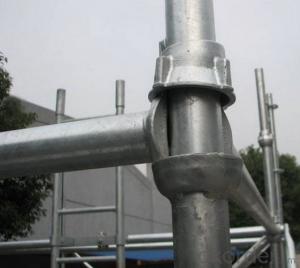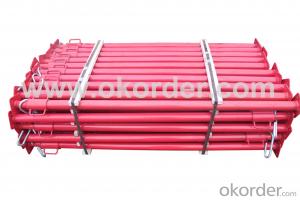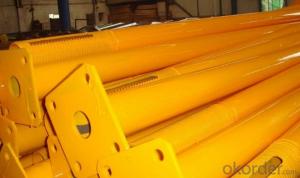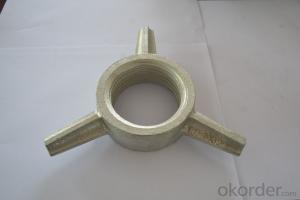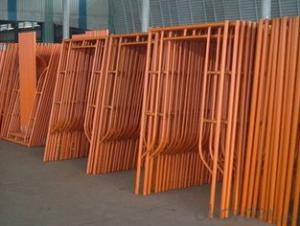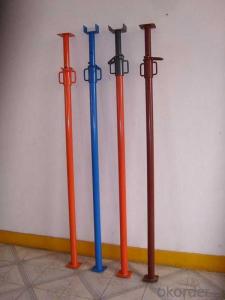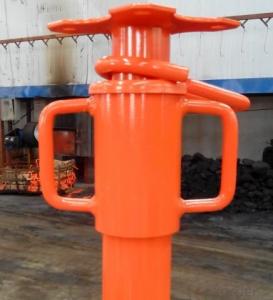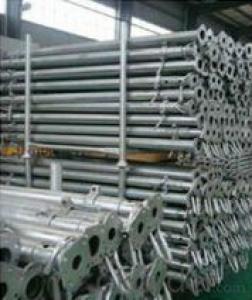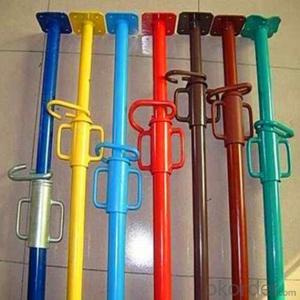Best Price Used Layher Scaffolding,Scaffolding Parts,Scaffolding Pipe Parts
- Loading Port:
- China Main Port
- Payment Terms:
- TT OR LC
- Min Order Qty:
- -
- Supply Capability:
- -
OKorder Service Pledge
OKorder Financial Service
You Might Also Like
Quick Details
| Minimum Order Quantity: | Material: |
| Model Number: | Surface Treatment: | ||||
| FOB Price: | Delivery Time: | Packing Details: |
Packaging & Delivery
| Packaging Detail: | Packed in woven bags or pallet. 25pieces one bag. |
| Delivery Detail: | Within 30days after receiving your advance payment or L/C |
Specifications
1.Material: Q195, Q235, etc
2.Advantage: easy combination, safety, stable
3.Surface: Pre galvanized
Specifications of the Product
1)size: 48.3mm
2) Min.Slip Load:10.5Mpa
3) Distortion Load:18KN
4) Weight: 0.5--1.5kg
5) superficial treatment: hot dip galvanized; galvanized
6) Material:Q235,Q195etc
7) Size for tube:45mm 47.5mm 48.3mm 50mm
8) Production technology: Drop forged
9) Surface treatment: Dipping paint, Zinc plated, Galvanized.
10) Color: Red, Self color, Gold color, Silver color or as per customized.
11) Application: Connect tow scaffolding pipe for arbitrary angle( Swivel)
12) Quality: Excellent Anti-Broken/ Anti-Slipping/Anti-Resisting/ Anti-Rusting/Easily Installing
13) Standard:EN74/BS1139 swivel coupler
- Q:What are the common signs of wear and tear in steel props?
- The signs of wear and tear in steel props can differ based on their specific use and conditions. However, there are some common indications to look out for: 1. Surface corrosion: Moisture and environmental conditions can cause rust spots or discoloration on the steel surface. 2. Deformation: Heavy loads, improper storage, or accidental impacts can lead to bending, warping, or buckling of the steel structure. 3. Cracks or fractures: Excessive weight or prolonged use may result in cracks or fractures on the main structural elements or at the joints. 4. Loose or damaged nuts and bolts: The fasteners connecting various components can become loose, damaged, or stripped, affecting stability and safety. 5. Increased movement or instability: Wear and tear can cause wobbling or shaking during use, compromising the structural integrity. 6. Reduced load-bearing capacity: Material fatigue, corrosion, or other forms of damage can decrease the prop's ability to support the intended load or cause visible signs of stress. 7. Deterioration of protective coatings: Peeling, cracking, or chipping of the protective coatings may occur over time. Regular inspections are crucial to ensure the continued safety and performance of steel props. If any of these signs are noticed, appropriate measures such as repairs, replacements, or strengthening should be taken.
- Q:What are the maintenance requirements for a steel prop?
- Regular cleaning and inspection are the primary maintenance requirements for a steel prop. To ensure optimal performance and long lifespan, it is crucial to keep the propeller free from debris, saltwater, and other contaminants. It is advised to wash the propeller regularly with fresh water after each use and utilize a mild detergent to eliminate any dirt or salt buildup. Furthermore, it is vital to inspect the propeller regularly for any indications of damage, such as dents, cracks, or bent blades. If any damage is noticed, it must be promptly addressed by a professional technician or propeller repair specialist to prevent further complications and potential failure. Moreover, it is recommended to periodically lubricate the propeller shaft to minimize friction and wear. The use of a marine-grade grease or lubricant can safeguard the propeller against corrosion and ensure smooth operation. Finally, it is of utmost importance to adhere to the manufacturer's guidelines and recommendations for maintenance and servicing. Each steel propeller may have specific care instructions, and following these guidelines will help maintain the propeller's performance and integrity. Regular professional inspections and services are also advised to efficiently identify and resolve any underlying issues.
- Q:Do steel props have a maximum extension limit?
- Yes, steel props do have a maximum extension limit. The maximum extension limit refers to the maximum length that a steel prop can be extended to safely support a load. This limit is determined by the manufacturer and is usually specified in the product specifications or guidelines. Exceeding the maximum extension limit can lead to structural instability and compromise the safety of the prop, the supported load, and the surrounding structures. It is important to always adhere to the recommended maximum extension limit provided by the manufacturer to ensure the proper and safe use of steel props.
- Q:What are the common causes of failure in steel props?
- Common causes of failure in steel props include excessive loads or overload, corrosion due to exposure to moisture or chemicals, improper installation or inadequate support, fatigue from repeated use or stress, and manufacturing defects.
- Q:How do steel props contribute to the stability of a structure?
- Steel props, also known as temporary support systems, play a crucial role in ensuring the stability of a structure during construction or renovation. These adjustable steel columns are typically used to provide temporary support to beams, slabs, walls, and other structural elements. Firstly, steel props help distribute the weight of the structure evenly by transferring the load from the upper levels to the foundation. This balanced weight distribution prevents excessive stress on any particular area, reducing the risk of structural failure or collapse. Furthermore, steel props provide vertical support, preventing sagging or deflection of beams and slabs. This is particularly important during construction when fresh concrete is poured and needs to cure properly. The props ensure that the weight of the wet concrete is evenly distributed, preventing any deformation or cracking that could compromise the overall stability of the structure. In addition, steel props contribute to the stability of a structure by providing lateral support. They help resist horizontal forces, such as wind or earthquakes, by bracing the walls or columns. This prevents excessive swaying or shifting of the structure, reducing the risk of damage or collapse in case of external forces. Moreover, steel props are adjustable, allowing for fine-tuning and precise leveling of the structure. This adjustability is essential when dealing with uneven ground or when aligning different structural components. By providing accurate vertical alignment, steel props ensure that the structure is stable and plumb. Overall, steel props are indispensable for maintaining the stability of a structure during construction or renovation. They evenly distribute the weight, provide vertical and lateral support, and allow for precise leveling. By utilizing steel props, construction projects can proceed safely, ensuring the structural integrity of the building.
- Q:Can steel props be used for supporting temporary tunnels?
- Yes, steel props can be used for supporting temporary tunnels. Steel props are commonly used in construction and excavation projects to provide temporary support to structures, including tunnels. They are adjustable, strong, and have the ability to withstand heavy loads, making them an ideal choice for supporting temporary tunnels during construction or renovation work.
- Q:Can steel props be used in residential foundation repair?
- Residential foundation repair can indeed utilize steel props. These props, also referred to as adjustable steel columns or steel shores, are a common sight in construction and foundation repair projects. Their purpose is to temporarily support structures that have been damaged or weakened, including residential foundations. The use of steel props in foundation repair brings forth several advantages. First and foremost, their adjustability allows for precise leveling and support of the foundation. This adaptability ensures that the props can cater to the specific requirements of the foundation, delivering optimal support. Moreover, steel props boast high durability and can withstand heavy loads, making them an excellent choice for residential foundation repair. Furthermore, steel props exhibit versatility and can be applied in various foundation repair techniques. For instance, they find utility in underpinning, a technique that revolves around fortifying and stabilizing an existing foundation. Steel props are also a common feature in foundation jacking, a process that focuses on raising and re-leveling a foundation that has sunk or settled. Nevertheless, it is crucial to seek advice from a professional engineer or foundation repair specialist before utilizing steel props in residential foundation repair. These experts possess the knowledge and skills to assess the specific conditions of the foundation and determine the most appropriate repair methods and materials. In summary, steel props represent a dependable and efficient solution for residential foundation repair. Their adjustable support, durability, and versatility make them a preferred option within the construction industry.
- Q:Do steel props require any special certifications or inspections?
- Steel props commonly necessitate special certifications and inspections to guarantee their adherence to industry standards and safety. These certifications and inspections are crucial as steel props are frequently utilized in construction projects to provide transient support during construction or renovation. The certification requirements may differ depending on the country or region, but generally, steel props must meet specific standards such as ISO 9001 (quality management), ISO 3834 (welding quality requirements), and EN 12811-1 (temporary works equipment). Accredited certification bodies, specializing in assessing construction equipment compliance with relevant standards, typically issue certifications for steel props. These bodies undertake comprehensive inspections and tests to ensure the props' structural integrity, load-bearing capacities, and ability to withstand expected working conditions. Conducting inspections on steel props is vital to verify their condition and confirm proper and safe usage on construction sites. Regular inspections aid in identifying potential defects or signs of wear and tear that could compromise the props' integrity and safety. Qualified personnel, such as structural engineers or certified inspectors, typically perform these inspections. They are trained to recognize problems and recommend necessary actions such as repairs or replacements. In conclusion, special certifications and inspections are typically necessary for steel props to ensure compliance with industry standards and guarantee safety on construction sites. These measures are implemented to safeguard workers and maintain the stability of structures during construction or renovation projects.
- Q:Do steel props require any special tools for installation?
- Yes, steel props typically require special tools for installation, such as spanners, wrenches, and hammers. These tools are used to adjust the height and secure the props in place, ensuring stability and safety during construction or renovation projects.
- Q:How do you calculate the number of steel props required for a specific task?
- To calculate the number of steel props required for a specific task, you need to consider several factors such as the weight and size of the load to be supported, the distance between the props, and the strength and capacity of the individual props. 1. Determine the weight and size of the load: The first step is to determine the weight and size of the load that needs to be supported. This will help you understand the load-bearing capacity required for the steel props. 2. Determine the spacing between the props: The next step is to determine the spacing between the props. This depends on the size and weight distribution of the load. Generally, the spacing should be such that it provides adequate support and stability to the load. 3. Check the load capacity of the steel props: Each steel prop has a load capacity, which is usually mentioned by the manufacturer. Check the load capacity of the steel props you have or plan to purchase. This will help you determine the maximum weight each prop can bear. 4. Calculate the load-bearing capacity required: Divide the total weight of the load by the load capacity of a single prop. This will give you an estimate of the number of props required to support the load. 5. Consider safety factors: It is important to factor in safety margins when calculating the number of steel props required. It is recommended to add an extra prop or two to ensure additional support and to account for any uncertainties or variations in load distribution. 6. Consider the type and quality of props: Different types of steel props have different load-bearing capacities. Consider the type and quality of the props you are using to ensure they meet the necessary safety standards and regulations. 7. Consult with a structural engineer or expert: If you are unsure or if the task involves complex load calculations, it is advisable to consult with a structural engineer or an expert in the field. They can provide guidance and help you calculate the number of steel props required accurately. Remember, it is essential to prioritize safety and adhere to all relevant regulations and guidelines when calculating the number of steel props required for a specific task.
1. Manufacturer Overview |
|
|---|---|
| Location | |
| Year Established | |
| Annual Output Value | |
| Main Markets | |
| Company Certifications | |
2. Manufacturer Certificates |
|
|---|---|
| a) Certification Name | |
| Range | |
| Reference | |
| Validity Period | |
3. Manufacturer Capability |
|
|---|---|
| a)Trade Capacity | |
| Nearest Port | |
| Export Percentage | |
| No.of Employees in Trade Department | |
| Language Spoken: | |
| b)Factory Information | |
| Factory Size: | |
| No. of Production Lines | |
| Contract Manufacturing | |
| Product Price Range | |
Send your message to us
Best Price Used Layher Scaffolding,Scaffolding Parts,Scaffolding Pipe Parts
- Loading Port:
- China Main Port
- Payment Terms:
- TT OR LC
- Min Order Qty:
- -
- Supply Capability:
- -
OKorder Service Pledge
OKorder Financial Service
Similar products
New products
Hot products
Hot Searches
Related keywords
